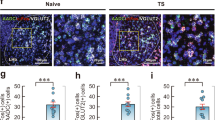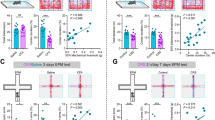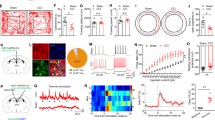Abstract
Neuropathic pain, which has become a major public health concern, is frequently accompanied by the deterioration of affective behavior and cognitive function. However, the brain circuitry underlying these changes is poorly understood. Therefore, we aimed to identify in a mouse model the converging circuit that influences the sensory, affective, and cognitive consequences of neuropathic pain. The lateral habenula (LHb) and ventral tegmental area (VTA) have been confirmed to play critical roles in the regulation of pain, cognition, and depression. Given the essential role of the LHb in depression and cognition, we attempted to clarify how neural circuitry involving the LHb integrates pain-related information. Our data confirmed that the VTA receives projections from the LHb, but our results suggest that inhibition of this direct pathway has no effect on the behavior of mice with chronic neuropathic pain. The rostromedial tegmental nucleus (RMTg), a GABAergic structure believed to underlie the transient inhibition of DAergic neurons in the VTA, received glutamatergic inputs from the LHb and projected strongly to the VTA. Furthermore, our data suggest that a projection from LHb glutamatergic neurons to RMTg GABAergic neurons in the VTA, constituting an indirect LHbGlu → RMTgGABA → VTADA pathway, participates in peripheral nerve injury-induced nociceptive hypersensitivity, depressive-like behavior, and cognitive dysfunction. Ex vivo extracellular recordings of LHb neurons showed that the proportion of burst-firing cells in the LHb was significantly increased in indirect projections rather than in direct projections. This may explain the functional discrepancies between direct and indirect projections of the LHb to the VTA. Collectively, our study identifies a pivotal role of the LHbGlu → RMTgGABA → VTADA pathway in processing pain. This pathway may offer new therapeutic targets to treat neuropathic pain and its associated depressive-like and cognitive impairments.

This is a preview of subscription content, access via your institution
Access options
Subscribe to this journal
Receive 13 print issues and online access
$259.00 per year
only $19.92 per issue
Buy this article
- Purchase on SpringerLink
- Instant access to full article PDF
Prices may be subject to local taxes which are calculated during checkout





Similar content being viewed by others
Data availability
All data are present in the main text or the Supplementary Materials. Additional data to support the findings of this study are available from the corresponding author upon request.
Change history
03 April 2025
A Correction to this paper has been published: https://doi.org/10.1038/s41386-025-02099-y
References
Komboz F, Mehsein Z, Kobaïter-Maarrawi S, Chehade HD, Maarrawi J. Epidural posterior insular stimulation alleviates neuropathic pain manifestations in rats with spared nerve injury through endogenous opioid system. Neuromodulation. 2022;26:1602–1611.
Devor M. Sodium channels and mechanisms of neuropathic pain. J Pain. 2006;7:S3–12.
Moriarty O, McGuire BE, Finn DP. The effect of pain on cognitive function: a review of clinical and preclinical research. Prog Neurobiol. 2011;93:385–404.
Malfliet A, Coppieters I, Van Wilgen P, Kregel J, De Pauw R, Dolphens M, et al. Brain changes associated with cognitive and emotional factors in chronic pain: a systematic review. Eur J Pain. 2017;21:769–86.
Alba-Delgado C, Llorca-Torralba M, Horrillo I, Ortega JE, Mico JA, Sánchez-Blázquez P, et al. Chronic pain leads to concomitant noradrenergic impairment and mood disorders. Biol Psychiatry. 2013;73:54–62.
May A. Chronic pain may change the structure of the brain. Pain. 2008;137:7–15.
Hu H, Cui Y, Yang Y. Circuits and functions of the lateral habenula in health and in disease. Nat Rev Neurosci. 2020;21:277–95.
Proulx CD, Hikosaka O, Malinow R. Reward processing by the lateral habenula in normal and depressive behaviors. Nat Neurosci. 2014;17:1146–52.
Wise RA. Dopamine, learning and motivation. Nat Rev Neurosci. 2004;5:483–94.
Hikosaka O. The habenula: from stress evasion to value-based decision-making. Nat Rev Neurosci. 2010;11:503–13.
Gu HW, Zhang GF, Liu PM, Pan WT, Tao YX, Zhou ZQ, et al. Contribution of activating lateral hypothalamus-lateral habenula circuit to nerve trauma-induced neuropathic pain in mice. Neurobiol Dis. 2023;182:106155.
Rossi MA, Basiri ML, Liu Y, Hashikawa Y, Hashikawa K, Fenno LE, et al. Transcriptional and functional divergence in lateral hypothalamic glutamate neurons projecting to the lateral habenula and ventral tegmental area. Neuron. 2021;109:3823–37.e6.
Wang C, Chen M, Qin C, Qu X, Shen X, Liu S. Lateral hypothalamic orexin neurons mediate the reward effects of pain relief induced by electroacupuncture. Front Mol Neurosci. 2022;15:812035.
Chen M, Ma S, Liu H, Dong Y, Tang J, Ni Z, et al. Brain region-specific action of ketamine as a rapid antidepressant. Science. 2024;385:eado7010.
Dai D, Li W, Chen A, Gao XF, Xiong L. Lateral habenula and its potential roles in pain and related behaviors. ACS Chem Neurosci. 2022;13:1108–18.
Kiening K, Sartorius A. A new translational target for deep brain stimulation to treat depression. EMBO Mol Med. 2013;5:1151–3.
Xin J, Shan W, Li J, Yu H, Zuo Z. Activation of the lateral habenula-ventral tegmental area neural circuit contributes to postoperative cognitive dysfunction in mice. Adv Sci. 2022;9:e2202228.
Engelhard B, Finkelstein J, Cox J, Fleming W, Jang HJ, Ornelas S, et al. Specialized coding of sensory, motor and cognitive variables in VTA dopamine neurons. Nature. 2019;570:509–13.
Morales M, Margolis EB. Ventral tegmental area: cellular heterogeneity, connectivity and behaviour. Nat Rev Neurosci. 2017;18:73–85.
Guang-Fen Z, Jie G, Jian-Jun Y. The lateral Habenula: role in chronic pain and depression. Translational perioperative and pain medicine. 2020;7:271–278.
Markovic T, Pedersen CE, Massaly N, Vachez YM, Ruyle B, Murphy CA, et al. Pain induces adaptations in ventral tegmental area dopamine neurons to drive anhedonia-like behavior. Nat Neurosci. 2021;24:1601–13.
Geisler S, Andres KH, Veh RW. Morphologic and cytochemical criteria for the identification and delineation of individual subnuclei within the lateral habenular complex of the rat. J Comp Neurol. 2003;458:78–97.
Ji H, Shepard PD. Lateral habenula stimulation inhibits rat midbrain dopamine neurons through a GABA(A) receptor-mediated mechanism. J Neurosci. 2007;27:6923–30.
Bourdy R, Barrot M. A new control center for dopaminergic systems: pulling the VTA by the tail. Trends Neurosci. 2012;35:681–90.
Lu YG, Wang L, Chen JL, Zhu J, Meng XY, You ZD, et al. Projections from lateral habenular to tail of ventral tegmental area contribute to inhibitory effect of stress on morphine-induced conditioned place preference. Brain Res. 2019;1717:35–43.
Batalla A, Homberg JR, Lipina TV, Sescousse G, Luijten M, Ivanova SA, et al. The role of the habenula in the transition from reward to misery in substance use and mood disorders. Neurosci Biobehav Rev. 2017;80:276–85.
Herkenham M, Nauta WJ. Efferent connections of the habenular nuclei in the rat. J Comp Neurol. 1979;187:19–47.
Gonçalves L, Sego C, Metzger M. Differential projections from the lateral habenula to the rostromedial tegmental nucleus and ventral tegmental area in the rat. J Comp Neurol. 2012;520:1278–300.
Yang Y, Cui Y, Sang K, Dong Y, Ni Z, Ma S, et al. Ketamine blocks bursting in the lateral habenula to rapidly relieve depression. Nature. 2018;554:317–22.
Zhang CK, Wang P, Ji YY, Zhao JS, Gu JX, Yan XX, et al. Potentiation of the lateral habenula-ventral tegmental area pathway underlines the susceptibility to depression in mice with chronic pain. Sci China Life Sci. 2024;67:67–82.
Wilcox KS, Gutnick MJ, Christoph GR. Electrophysiological properties of neurons in the lateral habenula nucleus: an in vitro study. J Neurophysiol. 1988;59:212–25.
Cui Y, Yang Y, Ni Z, Dong Y, Cai G, Foncelle A, et al. Astroglial Kir4.1 in the lateral habenula drives neuronal bursts in depression. Nature. 2018;554:323–7.
Wagner F, Weiss T, Veh RW. Electrophysiological properties of neurons and synapses in the lateral habenular complex (LHb). Pharmacol Biochem Behav. 2017;162:38–45.
Huang L, Xi Y, Peng Y, Yang Y, Huang X, Fu Y, et al. A visual circuit related to habenula underlies the antidepressive effects of light therapy. Neuron. 2019;102:128–42.e8.
Decosterd I, Woolf CJ. Spared nerve injury: an animal model of persistent peripheral neuropathic pain. Pain. 2000;87:149–58.
Llorca-Torralba M, Suárez-Pereira I, Bravo L, Camarena-Delgado C, Garcia-Partida JA, Mico JA, et al. Chemogenetic silencing of the locus coeruleus-basolateral amygdala pathway abolishes pain-induced anxiety and enhanced aversive learning in rats. Biol Psychiatry. 2019;85:1021–35.
Baker PM, Jhou T, Li B, Matsumoto M, Mizumori SJ, Stephenson-Jones M, et al. The lateral habenula circuitry: reward processing and cognitive control. J Neurosci. 2016;36:11482–8.
Björklund A, Dunnett SB. Dopamine neuron systems in the brain: an update. Trends Neurosci. 2007;30:194–202.
Bromberg-Martin ES, Matsumoto M, Hikosaka O. Dopamine in motivational control: rewarding, aversive, and alerting. Neuron. 2010;68:815–34.
Lammel S, Lim BK, Ran C, Huang KW, Betley MJ, Tye KM, et al. Input-specific control of reward and aversion in the ventral tegmental area. Nature. 2012;491:212–7.
Flores-García M, Rizzo A, Garçon-Poca MZ, Fernández-Dueñas V, Bonaventura J. Converging circuits between pain and depression: the ventral tegmental area as a therapeutic hub. Front Pharmacol. 2023;14:1278023.
Xia SH, Hu SW, Ge DG, Liu D, Wang D, Zhang S, et al. Chronic pain impairs memory formation via disruption of neurogenesis mediated by mesohippocampal brain-derived neurotrophic factor signaling. Biol Psychiatry. 2020;88:597–610.
Ungless MA, Magill PJ, Bolam JP. Uniform inhibition of dopamine neurons in the ventral tegmental area by aversive stimuli. Science. 2004;303:2040–2.
Yang H, de Jong JW, Cerniauskas I, Peck JR, Lim BK, Gong H, et al. Pain modulates dopamine neurons via a spinal-parabrachial-mesencephalic circuit. Nat Neurosci. 2021;24:1402–13.
Brischoux F, Chakraborty S, Brierley DI, Ungless MA. Phasic excitation of dopamine neurons in ventral VTA by noxious stimuli. Proc Natl Acad Sci USA. 2009;106:4894–9.
de Jong JW, Afjei SA, Pollak Dorocic I, Peck JR, Liu C, Kim CK, et al. A neural circuit mechanism for encoding aversive stimuli in the mesolimbic dopamine system. Neuron. 2019;101:133–51.e7.
Han Y, Ai L, Song L, Zhou Y, Chen D, Sha S, et al. Midbrain glutamatergic circuit mechanism of resilience to socially transferred allodynia in male mice. Nat Commun. 2024;15:4947.
Lammel S, Ion DI, Roeper J, Malenka RC. Projection-specific modulation of dopamine neuron synapses by aversive and rewarding stimuli. Neuron. 2011;70:855–62.
Qi J, Zhang S, Wang HL, Wang H, de Jesus Aceves Buendia J, Hoffman AF, et al. A glutamatergic reward input from the dorsal raphe to ventral tegmental area dopamine neurons. Nat Commun. 2014;5:5390.
Stamatakis AM, Jennings JH, Ung RL, Blair GA, Weinberg RJ, Neve RL, et al. A unique population of ventral tegmental area neurons inhibits the lateral habenula to promote reward. Neuron. 2013;80:1039–53.
Root DH, Mejias-Aponte CA, Qi J, Morales M. Role of glutamatergic projections from ventral tegmental area to lateral habenula in aversive conditioning. J Neurosci. 2014;34:13906–10.
Root DH, Mejias-Aponte CA, Zhang S, Wang HL, Hoffman AF, Lupica CR, et al. Single rodent mesohabenular axons release glutamate and GABA. Nat Neurosci. 2014;17:1543–51.
Jhou TC, Geisler S, Marinelli M, Degarmo BA, Zahm DS. The mesopontine rostromedial tegmental nucleus: a structure targeted by the lateral habenula that projects to the ventral tegmental area of Tsai and substantia nigra compacta. J Comp Neurol. 2009;513:566–96.
Sun Y, Cao J, Xu C, Liu X, Wang Z, Zhao H. Rostromedial tegmental nucleus-substantia nigra pars compacta circuit mediates aversive and despair behavior in mice. Exp Neurol. 2020;333:113433.
Yang SH, Yang E, Lee J, Kim JY, Yoo H, Park HS, et al. Neural mechanism of acute stress regulation by trace aminergic signalling in the lateral habenula in male mice. Nat Commun. 2023;14:2435.
Lisman JE. Bursts as a unit of neural information: making unreliable synapses reliable. Trends Neurosci. 1997;20:38–43.
Cerniauskas I, Winterer J, de Jong JW, Lukacsovich D, Yang H, Khan F, et al. Chronic stress induces activity, synaptic, and transcriptional remodeling of the lateral habenula associated with deficits in motivated behaviors. Neuron. 2019;104:899–915.e8.
Figee M, Riva-Posse P, Choi KS, Bederson L, Mayberg HS, Kopell BH. Deep brain stimulation for depression. Neurotherapeutics. 2022;19:1229–45.
Funding
This study was supported by STI2030-Major Projects (2021ZD0203100), Grants from the National Natural Science Foundation of China (No.82471244; No.82271257; No.82071228), Postgraduate Research & Practice Innovation Program of Jiangsu Province (No. KYCX23_3001), and Open Competition Grant from Xuzhou Medical University (JBGS202202).
Author information
Authors and Affiliations
Contributions
Conceptualization, YYL and YMZ; Methodology, YYL, KW and YTD; Investigation, YYL, XHC, AYG and RJ; Writing—Original Draft, YYL and YMZ; Supervision, YMZ and JLC.
Corresponding authors
Ethics declarations
Competing interests
The authors declare no competing interests.
Additional information
Publisher’s note Springer Nature remains neutral with regard to jurisdictional claims in published maps and institutional affiliations.
The original online version of this article was revised due to a retrospective Open Access cancellation.
Supplementary information
Rights and permissions
Springer Nature or its licensor (e.g. a society or other partner) holds exclusive rights to this article under a publishing agreement with the author(s) or other rightsholder(s); author self-archiving of the accepted manuscript version of this article is solely governed by the terms of such publishing agreement and applicable law.
About this article
Cite this article
Liu, Yy., Wu, K., Dong, Yt. et al. Lateral habenula induces cognitive and affective dysfunctions in mice with neuropathic pain via an indirect pathway to the ventral tegmental area. Neuropsychopharmacol. 50, 1039–1050 (2025). https://doi.org/10.1038/s41386-025-02084-5
Received:
Revised:
Accepted:
Published:
Issue date:
DOI: https://doi.org/10.1038/s41386-025-02084-5



